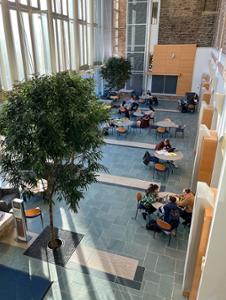
Biochemistry / Molecular Biology
About the Major
While courses in biology and chemistry introduce students to the life sciences, the Biochemistry/Molecular Biology Program offers scientific grounding for those planning to pursue graduate study or enter the health professions. Through laboratory work and research, students receive practical, hands-on training with opportunities to collaborate with professors on projects that lead to publication in research journals and presentations at scholarly conferences.
Students Will Learn To:
- Evaluate the scientific literature and other forms of professional communications in biochemistry and molecular biology
- Solve problems at the interfaces of chemistry and biology using scientific reasoning
- Communicate fundamental concepts of biochemistry and molecular biology to both expert and layperson in writing and oral presentations
A Sampling of Courses

Biological Chemistry
A survey of the chemical and physical nature of biological macromolecules, including nucleic acids, proteins, lipids and carbohydrates; biochemistry of enzyme catalysis; bioenergetics and regulatory mechanisms. Principles and techniques of experimental biochemistry, focusing on isolation methods and techniques for analyzing structure and function. This course satisfies the second semester of a one-year General Chemistry requirement for post-graduate Health Professions programs, however, this course might not also satisfy a Health Profession program’s requirement for a course in Biochemistry.
Explore these select courses:
A thematic course exploring five fundamental features of all biological systems, including structure and function, information flow, energy and matter, interactions, and evolution. Most ecosystems on Earth are shaped by plant life. While it may not seem like it, plants constantly do the same things we do: search for nutrients, secrete hormones, and defend themselves. In this course, we will explore the incredible adaptations plants use to survive and grow, compare these to adaptations of animals, and examine how plants provide the foundation for both ecosystems and human society.
The advanced study of biochemical pathways in living organisms, with emphasis given to gene regulation and metabolism of four major macromolecules: carbohydrates, lipids, proteins and nucleic acids. Includes in-depth discussion of contemporary developments in molecular biology and comprehensive training in molecular techniques. Three hours of class and three hours of laboratory.
Meet Our Faculty
Max Majireck
Associate Professor of Chemistry, Director of Biochemistry/ Molecular Biology
organic chemistry, natural products, medicinal chemistry and chemical biology
molecular biology; molecular evolution; genome structures; and bioinformatics
gene regulation; patterning and morphogenesis; transcription factors and DNA-binding; regulatory DNA; developmental genetics; molecular biology; embryology; eye development
biochemistry, bioinorganic chemistry, enzymology, and natural product biosynthesis
Genetics, molecular and cellular biology, bioethics, meiotic and mitotic chromosome segregation, spindle dynamics, fluorescence microscopy and live imaging
physical chemistry, biophysical chemistry, and theoretical chemistry
biochemistry and chemical biology
Faces & Spaces




Careers After Hamilton
Hamilton graduates who concentrated in biochemistry/molecular biology are pursuing careers in a variety of fields, including:
- Director, U.S. Regulatory Affairs, Pfizer Foundation
- Clinical Fellow, National Cancer Institute
- Plastic Surgeon, New York University Medical Center
- Neurosurgery Resident, Mount Sinai Hospital
- Senior Operations Analyst, Baxter Healthcare
- Pediatric Cardiologist, Hasbro Children’s Hospital
Explore Hamilton Stories

Two Hamilton chemistry students spent part of their summer unraveling a decades-old campus mystery – the true identity of the beloved peonies in Grant Garden. Saunders left behind scant documentation of what species he used to create his world-renowned hybrids. So, John “JP” Hoak ’27, Mark Khairallah ’27, and Biology Professor Wei-Jen Chang are sleuthing for clues not in records, but in DNA.

Combating Heart Disease Through Chemistry
Life-threatening diseases could become easier to detect thanks to a Hamilton student-faculty research team and its partnership with an internationally recognized biomedical research institute here in Utica.
Contact
Department Name
Biochemistry / Molecular Biology Program
Contact Name
Max Majireck, Program Director
Clinton, NY 13323







